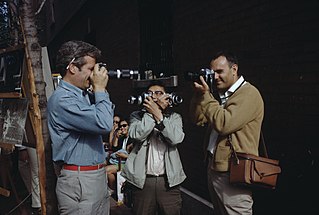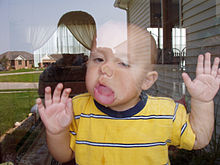
Photography is the art, application, and practice of creating images by recording light, either electronically by means of an image sensor, or chemically by means of a light-sensitive material such as photographic film. It is employed in many fields of science, manufacturing, and business, as well as its more direct uses for art, film and video production, recreational purposes, hobby, and mass communication.

A camera is an instrument used to capture and store images and videos, either digitally via an electronic image sensor, or chemically via a light-sensitive material such as photographic film. As a pivotal technology in the fields of photography and videography, cameras have played a significant role in the progression of visual arts, media, entertainment, surveillance, and scientific research. The invention of the camera dates back to the 19th century and has since evolved with advancements in technology, leading to a vast array of types and models in the 21st century.

A twin-lens reflex camera (TLR) is a type of camera with two objective lenses of the same focal length. One of the lenses is the photographic objective or "taking lens", while the other is used for the viewfinder system, which is usually viewed from above at waist level.

A box camera is a simple type of camera, the most common form being a cardboard or plastic box with a lens in one end and film at the other. They were sold in large numbers during the late 19th and early 20th centuries. The lenses are often single element designs meniscus fixed focus lens, or in better quality box cameras a doublet lens with minimal possible adjustments to the aperture or shutter speeds. Because of the inability to adjust focus, the small lens aperture and the low sensitivity of the sensitive materials available, these cameras work best in brightly lit day-lit scenes when the subject is within the hyperfocal distance for the lens and of subjects that move little during the exposure. Eventually, box cameras with photographic flash, shutter and aperture adjustment were introduced, allowing indoor photos.

The Brownie was a series of camera models made by Eastman Kodak and first released in 1900.

A flash is a device used in photography that produces a brief burst of light at a color temperature of about 5,500 K to help illuminate a scene. A major purpose of a flash is to illuminate a dark scene. Other uses are capturing quickly moving objects or changing the quality of light. Flash refers either to the flash of light itself or to the electronic flash unit discharging the light. Most current flash units are electronic, having evolved from single-use flashbulbs and flammable powders. Modern cameras often activate flash units automatically.
The Instamatic is a series of inexpensive, easy-to-load 126 and 110 cameras made by Kodak beginning in 1963. The Instamatic was immensely successful, introducing a generation to low-cost photography and spawning numerous imitators.

An instant camera is a camera which uses self-developing film to create a chemically developed print shortly after taking the picture. Polaroid Corporation pioneered consumer-friendly instant cameras and film, and were followed by various other manufacturers.

Street photography is photography conducted for art or inquiry that features unmediated chance encounters and random incidents within public places, usually with the aim of capturing images at a decisive or poignant moment by careful framing and timing. Although there is a difference between street and candid photography, it is usually subtle with most street photography being candid in nature and some candid photography being classifiable as street photography. Street photography does not necessitate the presence of a street or even the urban environment. Though people usually feature directly, street photography might be absent of people and can be of an object or environment where the image projects a decidedly human character in facsimile or aesthetic.

Garry Winogrand was an American street photographer, known for his portrayal of U.S. life and its social issues, in the mid-20th century. Photography curator, historian, and critic John Szarkowski called Winogrand the central photographer of his generation.

Chronophotography is a photographic technique from the Victorian era which captures a number of phases of movements. The best known chronophotography works were mostly intended for the scientific study of locomotion, to discover practical information for animal handlers and/or as reference material for artists. Although many results were not intended to be exhibited as moving pictures, there is much overlap with the more or less simultaneous quest to register and exhibit photographic motion pictures.

The Bulb setting on camera shutters is a momentary-action mode that holds shutters open for as long as a photographer depresses the shutter-release button. The Bulb setting is distinct from shutter's Time (T) setting, which is an alternate-action mode where the shutter opens when the shutter-release button is pressed and released once, and closes when the button is actuated again.

The history of photography began with the discovery of two critical principles: The first is camera obscura image projection, the second is the discovery that some substances are visibly altered by exposure to light. There are no artifacts or descriptions that indicate any attempt to capture images with light sensitive materials prior to the 18th century.
Documentary photography usually refers to a popular form of photography used to chronicle events or environments both significant and relevant to history and historical events as well as everyday life. It is typically undertaken as professional photojournalism, or real life reportage, but it may also be an amateur, artistic, or academic pursuit.

The history of the camera began even before the introduction of photography. Cameras evolved from the camera obscura through many generations of photographic technology – daguerreotypes, calotypes, dry plates, film – to the modern day with digital cameras and camera phones.
The term vernacular photography is used in several related senses. Each is in one way or another meant to contrast with received notions of fine-art photography. Vernacular photography is also distinct from both found photography and amateur photography. The term originated among academics and curators, but has moved into wider usage.
The following outline is provided as an overview of and topical guide to photography:
New Documents was an influential documentary photography exhibition at Museum of Modern Art, New York, in 1967, curated by John Szarkowski. It presented photographs by Diane Arbus, Lee Friedlander and Garry Winogrand and is said to have "represented a shift in emphasis" and "identified a new direction in photography: pictures that seemed to have a casual, snapshot-like look and subject matter so apparently ordinary that it was hard to categorize".
The practice and appreciation of photographyin the United States began in the 19th century, when various advances in the development of photography took place and after daguerreotype photography was introduced in France in 1839. The earliest commercialization of photography was made in the country when Alexander Walcott and John Johnson opened the first commercial portrait gallery in 1840. In 1866, the first color photograph was taken. Only in the 1880s, would photography expand to a mass audience with the first easy-to-use, lightweight Kodak camera, issued by George Eastman and his company.

The Kodak Panoram camera was a roll-film swing-lens panoramic camera made in Rochester, New York, USA by Eastman Kodak between 1899 and 1928.
















